“Thar she blows!” someone cried as puffs of vapour sprayed out from a pair of blowholes. Chins stopped wagging, giving way to the whopping 40-tonne whale breaching. Or so we’d been informed, the day before we arrived at Guerrero Negro. The prospect of encountering a mammal—post their long migration—the length of a semi-trailer truck at 6,000-stone, got me going.

An osprey eyeing us up en route to the whale watching.
I had eavesdropped on the vertebrates warbling their haunting, unearthly songs underwater many times before when scuba diving. Listening intently to a baffling concert of cries, moans, squeaks, clicks and whistles. I’d seen them occasionally breaching on the horizon, including partial glimpses of a lone one playing in the warm waters off San Felipe, further up the Baja. Although I’d never seen a big blighter from the surface less than 20-metres away, let alone at arm’s length. Could it be..would it happen?
These tireless travellers commute up to 12,000 miles (the longest known migration of any mammal), the entire length along the North American Pacific Coast between their summer feeding grounds in Arctic waters to their winter breeding grounds in the Baja. Congregating inside four mangrove-lined breeding lagoons, they come to the peninsula to mate (or learn how to if it’s a juvenile), socialise and nurse their calves.
In the short season from early February through the end of April, the calves have a little more blubber on their bones, which suggests the mothers relax a little towards their young’s vulnerability. As such, behaviours become better known by some as ‘Friendly whale syndrome.’ The phenomenon of the “friendlies,” I was told, means that a grey whale just might approach our small boat and allow it to be touched by me. Leagues beyond my comprehension if that were to happen.
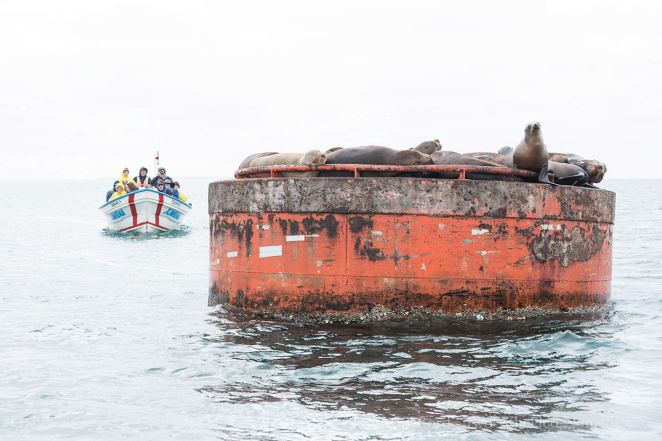
On our way to the whales…
A myth or not, we’d timed our arrival smack bang in the hot-season for essentially the world’s oceanic population of greys, in waters off a peninsula no bigger than a giant chilli. Riding a wave of optimism, to my mind, made the odds pretty favourable for a friendly citation rendezvous.
Let’s be honest though, I’d have to be patient without expecting to find my quarry in the first five minutes. Grey whales can stay submerged for 20 to 30 minutes after all. And prepare myself to see a mere few at perhaps, a faraway distance. I had neither a brilliant zoom lens nor a decent pair of binoculars to hone in on any smudges on the horizon. Let alone any spurts of mist only to be snatched away by the wind. That said, Jacques Cousteau labelled the Baja “the world’s aquarium” and our certified guide at Mario’s Tours was adamant we would see waters full of whales. Both left me hopeful and hurried to see them.
Jumping aboard our panga, a modest-sized, fibreglass fishing boat with five other whale-hungry passengers, took us out into Laguna Ojo de Liebre off Guerrero Negro, the wild Pacific coast of Mexico. Named after Charles M. Scammon in recognition of the extraordinary diversity of marine life. Still, that was no thanks to Charlie boy, who was one of the founders of the Pacific Coastal Whaling Industry. He and many others hunted ruthlessly in the second half of the 19th century and into the early 20th century, bringing the greys to near-extinction. Nice one, Scammon.

Feeding the birds: A seldom sighting of the odd dead whale is a wholly natural occurrence, all part of nature.
American whalers entered the Baja lagoons in small wooden rowing boats (on a par with the whale-watching pangas) and speared at them—barbarically—with harpoons. But the whales fought back: ferociously charging the whalers, ramming the boats with their heads, flipping them high into the air and smashing the crafts to smithereens with their tails. Because they fought like devils, the perpetrators dubbed them “devilfish”.
Fortunately, common sense has prevailed. Coupled with strenuous conservation efforts, the winter calving lagoons are now highly protected waters. Removed from the endangered species list in 1994, I asked our guide around how many whales have been sighted this year. “There’ve been around 2,000 whales known to frequent these waters,” I was loosely informed. However, on one recent count I was officially told 75 mother and calf pairs were tallied, along with 129 single whales.
Okay, so I might spot one or two then—the modern greys had been around for the last 150 to 160,000-years but I had less than a week to see them. As much as you can’t rely on divine intervention, and knowing that fate favours the bad as much as the good, I succeeded in keeping the faith; spurred on by a risky buzz of anticipation.
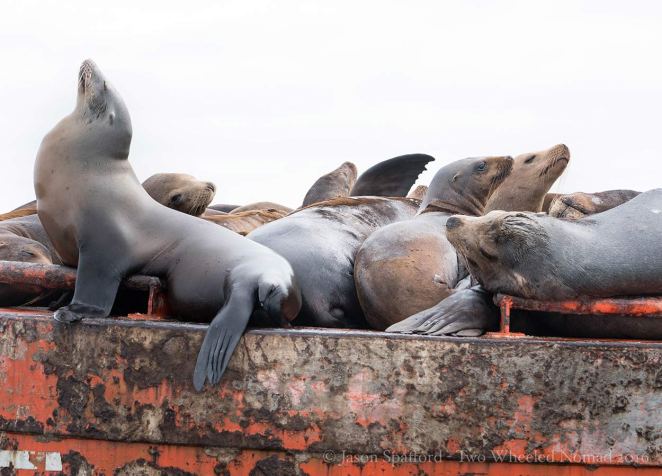
Lazy days on the Baja.
The first I saw of any grey was one already eyeing me up. I spied an adult male spyhop—its enormous head poking vertically out of the water, jaw facing me square on—in the hopes of getting a better view of any topside activity. A fleeting but fabulous sight where it was hard to tell who was supposed to be watching whom.
And then a mother and her calf fluidly cruised by, and another, and another. I started to lose count, pairs were coming in and out of view almost everywhere. For a moment, I couldn’t get the gears to mesh. One pair inching ever closer, I was able to engage. “Come on momma, come play. Bring your baby, he wants to play too!” I kept voicing as I launched sizable splashes over her head. It didn’t happen straight away but after enough pleading come-hithers, wearing my heart on my sleeve, a baby playfully swam right underneath our boat. Furiously fast, that was it. I was a whale addict.
With only vague pictures in my mind’s eye from reference books and Google images to go by, I’d drawn a mental visual of a baby whale that was completely at variance with his inquisitive eyes, expressive mouth and flawless skin. Gentle little giant and what a handsome face—never far from a smile. His eyes danced with a great generosity of spirit—it took a moment to stop my heart’s wild tattoo.

Giant giant of the sea.
Then bedlam broke loose. A broiling cloud of bubbles erupted from below, followed by a gurgling sound signalling a whale’s approach and then an unapologetically large head, glistening in the sun, bobbed up right alongside us. It was mum—all 15-metres of her—who is always close keeping a beady eye on proceedings. Seeing her appear suddenly, from fathom knows how deep, was like watching a Royal Navy nuclear submarine surface. But with an easy familiarity, even she was open to the occasional chin-scratch and belly-tickle. Thrillingly uplifting doesn’t come close to the tidal wave of joy that washed over me.
Through clear blue-green water, the mum’s skin complexion showed up: grey patches intermingled by white mottling, scratches and scars from a few war wounds streaked down her body including some tooth-rake marks from Orcas. Orange whale lice were visible amid the lumpy barnacles—sharp enough to cut your hand open. Interestingly, the tiny creatures secrete cement that hardens into plates, which surround them throughout their entire lives. As the plates meld together, the whale’s skin is pulled into the spaces between the plates, permanently fusing the barnacles to the whale.
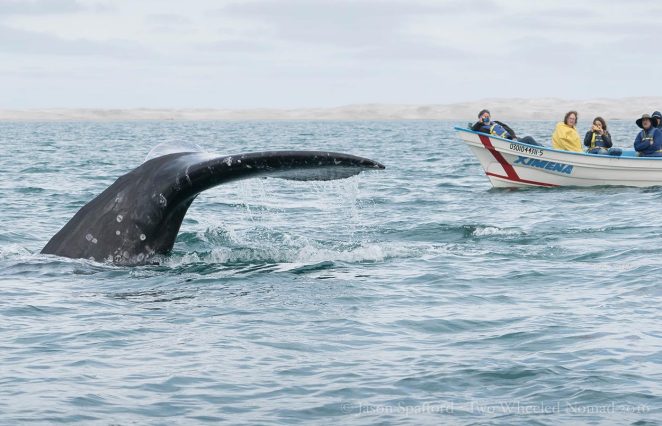
Down she goes.
For the entirety of the barnacles’ lives, they exist as diminutive hitchhikers enjoying a whale of a ride on the backs and bellies of the accommodating baleens. When the whales swim into plankton-rich waters to feed, so do the barnacles. The whale-riding barnacles also enjoy a certain degree of security from the mobility of their gigantic bodyguards. Still, for the most part, whale barnacles are harmless, even in astonishingly large numbers.
On the plus side, the barnacles can protect the whales, like a suit of armour. Greys have been known to roll over when under attack from other whales, presenting their enemies with a back covered in hard, spiny, immovable soldiers. It’s a commensalistic form of symbiosis, in which only one species benefits without causing significant harm to the other but actually, I think the whales would be worse for wear without them.
Scientists are confident the creatures like noise, so it’s no wonder the whales loiter. Greedy for more, I spotted several mothers using our boat as shelter from two males trying to mate her. It worked a charm and the feisty chaps were kept waiting. Other males in the area were having their way, where it takes two of them to engage the female; one to hold up her enormous bulk on the surface, and the other, well—it’s member being dubbed the animal kingdom’s largest ‘Pink Floyd’ (in comparison to its body) is prehensile. Namely, capable of grasping, so you get the idea.
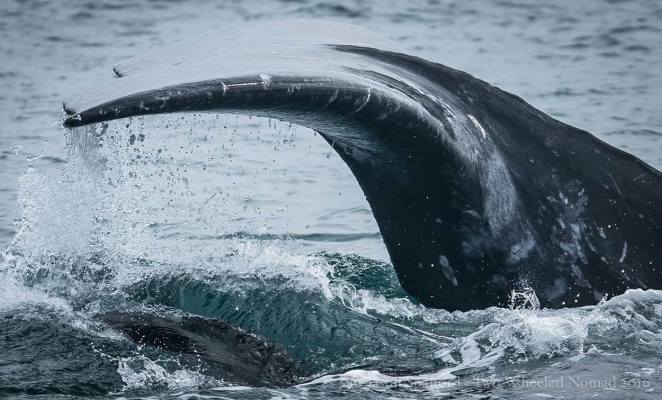
Some feisty mating action on the surface.
When the males migrate from the north and come into the warm ‘sure thing’ lagoons off the Pacific, a guide from Mario’s Tours mentioned that the adult males arrive with ownership of 300-pound testicles. Upon leaving, they depart with ones half the weight. Hugely sceptical about that, there was no denying that these boys sure have fun on the Baja, eh? I couldn’t help but think of Free Willy.
Minutes passed and the baby bobbed up again, only close enough with an expression in his eye inviting me to get tickling. Trusting as a kitten, I dived in all hands and heart, but I may as well have been standing on the fifth ring of Saturn. Aside from a howler monkey drape over my shoulders and having a manta ray accidentally land on my head once, I’d never engaged in anything this intimate with wildlife.
Pairs sporadically came alongside our panga, often times giving us a mild nudge. The boat handler smiled fondly at when they sometimes push the craft round in circles, or even raise them up, and then gently drop them back into the water. With only flippers, how else are they supposed to measure us up? These whales had our number, without doubt.
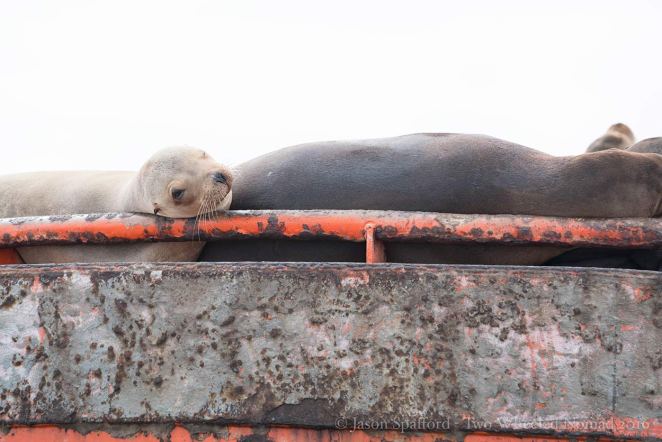
Getting winked by a seal.
Just a brief flirtation with a friendly grey was all it took to turn regular, quiet, conservative people into colourful, jibber-jabbering gushers. Everyone aboard our boat became these emotionally loud and flamboyant souls. I saw adult men and women break into song, tear up, grab the tissues while embracing each other and wildly punching the air. Doing all the things that regular, discreet and conservative types don’t usually do. Red-handed from all the high-fiving, I was just as guilty and fell under the whale’s spell, knowing that my life had been touched in a way it wouldn’t be again.
Nowadays, the new generation whales seem more accepting of the boats and curious to our presence. Welcoming us with open flippers, at last we come as friend, not foe. Certainly in these waters, we were. How they can trust us after all those years of irresponsible, reckless cruelty is something I’ve yet to fathom.
Only back on shore, could I start to process the humbling experience. The encounter opened a gulf of happiness and one that could only be filled by the same species. Stephen Fry summed it up best. I’d read that during a fortnight filming in the Baja, for the BBC television series Last Chance to See, he became a lifelong whale lover after his first day in San Ignacio. “Suck my pants and call me Noreen,” he said. “That was the best day of my life…Epic. Epic. Epic.” Yep. It would take about the same to parachute me down from this one.
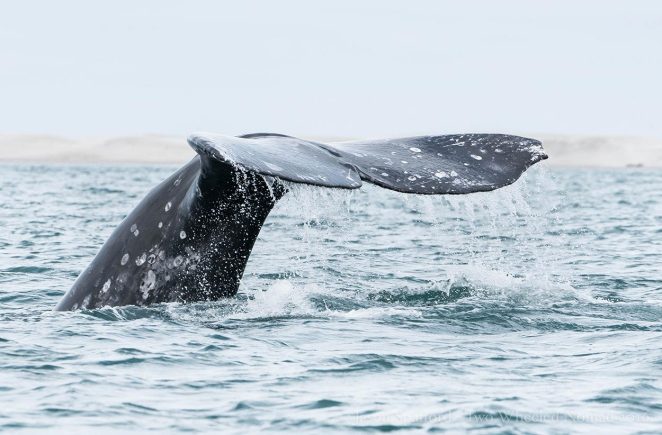
She’ll be back and so will we.

Interesting!!
LikeLike
Cheers Bob! L&J
LikeLike
Such a wonderful experience.
LikeLike
Hope you get a similar one, Terry ;o)
LikeLiked by 1 person